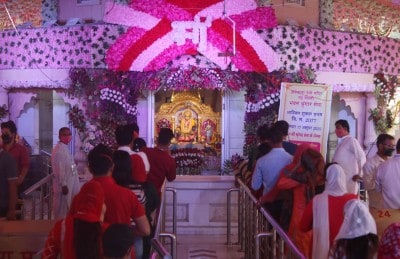New Delhi, Oct 17 : With the first day of Navratri on Saturday, the festival season has begun. But unlike other years, the pandemic is a major concern for most of Delhi’s iconic temples like Jhandewalan and Kalkaji, who are taking measures to strike a balance between honouring religiosity and adhering to COVID precautions. In others like the Noida Kali Bari, ‘bhog’ (prasad) distribution and ‘dhak’ have become things of the past.
The Jhandewalan temple situated near Delhi’s Karol Bagh is dedicated to the Goddess Aadi Shakti. The shrine is said to be built at the same place where an ardent devotee named Badri Bhagat had dreamt of an idol hidden under the ground, ages ago. After excavation, he had discovered the image of the Goddess. Ever since, the temple has held an iconic place in Delhi’s socio-religious life and all the more so during the 9 days of Navratri. The temple will open at 4 in the morning and close after 12 in the night, everyday.
However, this year the crowd has been comparatively thinner on the first day. This is predominantly because of the raging pandemic. At the main entrance, there is a temple assistant who provides hand sanitizer that every devotee has to use. Then there’s a second step where a paramedic checks the temperature. The devotee will be allowed to proceed further only if it is normal. Moreover, it will be a revolving crowd that won’t be allowed to stop. During darshan, devotees have to wear face masks and maintain adequate distance from each other.
In south Delhi’s Kalkaji, another iconic temple stop in Delhi, the rules are almost the same — sanitize hands, temperature check, wear face mask and maintain physical distance. However, when an IANS correspondent visited the temple, it was seen that physical distancing was not being maintained outside the gate where devotees queue up. But the rules of physical distancing were being observed inside the temple premises.
Devotees can have ‘darshan’ from a distance at Kalkaji temple. However, a priest confirmed to IANS that neither offering prasad, nor getting it in return, is being allowed this time.
CR Park, which is the heart of Durga Puja celebrations in the national capital, is muted this year with almost all Puja Committees having decided against holding Puja that attracts hundreds and thousands of people. However, the iconic Kali temple will hold a Durga Puja in a “very small fashion”. No Dhak, no outsiders.
It may not be in Delhi, but Noida’s Sector 26 Kali Bari holds one of the biggest Durga Puja in the suburbs. Free lunch for days, cultural activities and a big crowd — all will be replaced with a simple ghat (kalash) Puja where the organizing committee has decided against even a Goddess Durga idol.
Earlier, with Durga Puja round the corner and heralding the festival season, the Delhi Disaster Management Authority (DDMA) last Sunday issued fresh guidelines for holding gatherings, with strict adherence to Covid-19 protocols.
The order stipulates separate entry and exit at every event site, crowd regulation in terms of allowing only people with face masks, among other measures. In closed venues, upto 50 per cent of the hall capacity is allowed, which should not cross 200, while in open areas, the size of the ground and the Union Home Ministry’s SOPs will determine the numbers of individuals.
Disclaimer: This story is auto-generated from IANS service.

